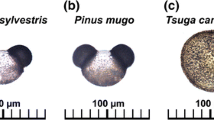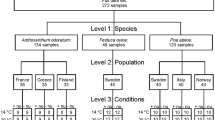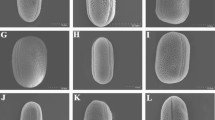Abstract
Main conclusion
Chemical imaging of pollen by vibrational microspectroscopy enables characterization of pollen ultrastructure, in particular phenylpropanoid components in grain wall for comparative study of extant and extinct plant species.
A detailed characterization of conifer (Pinales) pollen by vibrational microspectroscopy is presented. The main problems that arise during vibrational measurements were scatter and saturation issues in Fourier transform infrared (FTIR), and fluorescence and penetration depth issues in Raman. Single pollen grains larger than approx. 15 µm can be measured by FTIR microspectroscopy using conventional light sources, while smaller grains may be measured by employing synchrotron light sources. Pollen grains that were larger than 50 µm were too thick for FTIR imaging since the grain constituents absorbed almost all infrared light. Chemical images of pollen were obtained on sectioned samples, unveiling the distribution and concentration of proteins, carbohydrates, sporopollenins and lipids within pollen substructures. The comparative analysis of pollen species revealed that, compared with other Pinales pollens, Cedrus atlantica has a higher relative amount of lipid nutrients, as well as different chemical composition of grain wall sporopollenin. The pre-processing and data analysis, namely extended multiplicative signal correction and principal component analysis, offer simple estimate of imaging spectral data and indirect estimation of physical properties of pollen. The vibrational microspectroscopy study demonstrates that detailed chemical characterization of pollen can be obtained by measurement of an individual grain and pollen ultrastructure. Measurement of phenylpropanoid components in pollen grain wall could be used, not only for the reconstruction of past environments, but for assessment of diversity of plant species as well. Therefore, analysis of extant and extinct pollen species by vibrational spectroscopies is suggested as a valuable tool in biology, ecology and palaeosciences.







Similar content being viewed by others
References
Agarwal UP (2006) Raman imaging to investigate ultrastructure and composition of plant cell walls: distribution of lignin and cellulose in black spruce wood (Picea mariana). Planta 224(5):1141–1153. doi:10.1007/s00425-006-0295-z
Ahlers F, Thom I, Lambert J, Kuckuk R, Wiermann R (1999) H-1 NMR analysis of sporopollenin from Typha angustifolia. Phytochemistry 50(6):1095–1098
Barnes RJ, Dhanoa MS, Lister SJ (1989) Standard normal variate transformation and de-trending of near-infrared diffuse reflectance spectra. Appl Spectrosc 43(5):772–777. doi:10.1366/0003702894202201
Barron C, Parker ML, Mills EN, Rouau X, Wilson RH (2005) FTIR imaging of wheat endosperm cell walls in situ reveals compositional and architectural heterogeneity related to grain hardness. Planta 220(5):667–677. doi:10.1007/s00425-004-1383-6
Bassan P, Kohler A, Martens H, Lee J, Byrne HJ, Dumas P, Gazi E, Brown M, Clarke N, Gardner P (2010a) Resonant Mie Scattering (RMieS) correction of infrared spectra from highly scattering biological samples. Analyst 135:268–277
Bassan P, Kohler A, Martens H, Lee J, Jackson E, Lockyer N, Dumas P, Brown M, Clarke N, Gardner P (2010b) RMieS-EMSC correction for infrared spectra of biological cells: extension using full Mie theory and GPU computing. J Biophotonics 3:609–620
Blokker P, Boelen P, Broekman R, Rozema J (2006) The occurrence of p-coumaric acid and ferulic acid in fossil plant materials and their use as UV-proxy. Plant Ecol 182(1–2):197–207. doi:10.1007/s11258-005-9026-y
Boyain-Goitia AR, Beddows DCS, Griffiths BC, Telle HH (2003) Single-pollen analysis by laser-induced breakdown spectroscopy and Raman microscopy. Appl Opt 42(30):6119. doi:10.1364/ao.42.006119
Chen J, Sun S, Zhou Q (2013) Direct observation of bulk and surface chemical morphologies of Ginkgo biloba leaves by Fourier transform mid- and near-infrared microspectroscopic imaging. Anal Bioanal Chem 405(29):9385–9400. doi:10.1007/s00216-013-7366-3
Chylińska M, Szymańska-Chargot M, Zdunek A (2014) Imaging of polysaccharides in the tomato cell wall with Raman microspectroscopy. Plant Methods 10(14):1–9
Dell’Anna R, Lazzeri P, Frisanco M, Monti F, Malvezzi Campeggi F, Gottardini E, Bersani M (2009) Pollen discrimination and classification by Fourier transform infrared (FT-IR) microspectroscopy and machine learning. Anal Bioanal Chem 394(5):1443–1452. doi:10.1007/s00216-009-2794-9
Dokken KM, Davis LC, Marinkovic NS (2005) Use of infrared microspectroscopy in plant growth and development. Appl Spectrosc Rev 40(4):301–326. doi:10.1080/05704920500230898
Dumas P, Polack F, Lagarde B, Chubar O, Giorgetta JL, Lefrançois S (2006) Synchrotron infrared microscopy at the French Synchrotron Facility SOLEIL. Infrared Phys Technol 49:152–160
Fackler K, Thygesen LG (2013) Microspectroscopy as applied to the study of wood molecular structure. Wood Sci Technol 47(1):203–222. doi:10.1007/s00226-012-0516-5
Gierlinger N, Schwanninger M (2006) Chemical imaging of poplar wood cell walls by confocal Raman microscopy. Plant Physiol 140(4):1246–1254. doi:10.1104/pp.105.066993
Gierlinger N, Keplinger T, Harrington M (2012) Imaging of plant cell walls by confocal Raman microscopy. Nat Protoc 7(9):1694–1708. doi:10.1038/nprot.2012.092
Gorzsas A, Stenlund H, Persson P, Trygg J, Sundberg B (2011) Cell-specific chemotyping and multivariate imaging by combined FT-IR microspectroscopy and orthogonal projections to latent structures (OPLS) analysis reveals the chemical landscape of secondary xylem. Plant J Cell Mol Biol 66(5):903–914. doi:10.1111/j.1365-313X.2011.04542.x
Gottardini E, Rossi S, Cristofolini F, Benedetti L (2007) Use of Fourier transform infrared (FT-IR) spectroscopy as a tool for pollen identification. Aerobiologia 23(3):211–219
Ilari JL, Martens H, Isaksson T (1988) Determination of particle-size in powders by scatter correction in diffuse near-infrared reflectance. Appl Spectrosc 42(5):722–728. doi:10.1366/0003702884429058
Ivleva NP, Niessner R, Panne U (2005) Characterization and discrimination of pollen by Raman microscopy. Anal Bioanal Chem 381(1):261–267. doi:10.1007/s00216-004-2942-1
Jungfermann C, Ahlers F, Grote M, Gubatz S, Steuernagel S, Thom I, Wetzels G, Wiermann R (1997) Solution of sporopollenin and reaggregation of a sporopollenin-like material: a new approach in the sporopollenin research. J Plant Physiol 151(5):513–519
Kohler A, Kirschner C, Oust A, Martens H (2005) Extended multiplicative signal correction as a tool for separation and characterization of physical and chemical information in Fourier transform infrared microscopy images of cryo-sections of beef loin. Appl Spectrosc 59(6):707–716. doi:10.1366/0003702054280649
Lasch P, Naumann D (2006) Spatial resolution in infrared microspectroscopic imaging of tissues. Biochim Biophys Acta 1758(7):814–829. doi:10.1016/j.bbamem.2006.06.008
Laucks ML, Roll G, Schweigers G, Davis EJ (2000) Physical and chemical (Raman) characterization of bioaerosols-pollen. J Aerosol Sci 31:307–319
Lin CP, Huang JP, Wu CS, Hsu CY, Chaw SM (2010) Comparative chloroplast genomics reveals the evolution of Pinaceae genera and subfamilies. Genome Biol Evol 2:504–517. doi:10.1093/gbe/evq036
Lomax BH, Fraser WT, Harrington G, Blackmore S, Sephton MA, Harris NBW (2012) A novel palaeoaltimetry proxy based on spore and pollen wall chemistry. Earth Planet Sci Lett 353:22–28. doi:10.1016/j.epsl.2012.07.039
Lukacs R, Blumel R, Zimmermann B, Bagcoglu M, Kohler A (2015) Recovery of absorbance spectra of micrometer-sized biological and inanimate particles. Analyst. doi:10.1039/C5AN00401B
Martens H, Stark E (1991) Extended multiplicative signal correction and spectral interference subtraction—new preprocessing methods for near-infrared spectroscopy. J Pharm Biomed 9(8):625–635. doi:10.1016/0731-7085(91)80188-F
Pappas CS, Tarantilis PA, Harizanis PC, Polissiou MG (2003) New method for pollen identification by FT-IR spectroscopy. Appl Spectrosc 57(1):23–27
Pappas D, Smith BW, Winefordner JD (2004) Raman imaging for two-dimensional chemical analysis. Appl Spectrosc Rev 35(1–2):1–23. doi:10.1081/asr-100101219
Parodi G, Dickerson P, Cloud J (2013) Pollen identification by Fourier transform infrared photoacoustic spectroscopy. Appl Spectrosc 67(3):342–348. doi:10.1366/12-06622
Schulte F, Lingott J, Panne U, Kneipp J (2008) Chemical characterization and classification of pollen. Anal Chem 80(24):9551–9556. doi:10.1021/Ac801791a
Schulte F, Mader J, Kroh LW, Panne U, Kneipp J (2009) Characterization of pollen carotenoids with in situ and high-performance thin-layer chromatography supported resonant Raman spectroscopy. Anal Chem 81(20):8426–8433
Schulte F, Panne U, Kneipp J (2010) Molecular changes during pollen germination can be monitored by Raman microspectroscopy. J Biophotonics 3(8–9):542–547. doi:10.1002/jbio.201000031
Schulz H, Baranska M (2007) Identification and quantification of valuable plant substances by IR and Raman spectroscopy. Vib Spectrosc 43(1):13–25. doi:10.1016/j.vibspec.2006.06.001
Wehling K, Niester C, Boon JJ, Willemse MTM, Wiermann R (1989) P-coumaric acid—a monomer in the sporopollenin skeleton. Planta 179(3):376–380
Willis KJ, Feurdean A, Birks HJ, Bjune AE, Breman E, Broekman R, Grytnes JA, New M, Singarayer JS, Rozema J (2011) Quantification of UV-B flux through time using UV-B-absorbing compounds contained in fossil Pinus sporopollenin. New Phytol 192(2):553–560. doi:10.1111/j.1469-8137.2011.03815.x
Yu P (2011) Microprobing the molecular spatial distribution and structural architecture of feed-type sorghum seed tissue (Sorghum Bicolor L.) using the synchrotron radiation infrared microspectroscopy technique. J Synchrotron Radiat 18(Pt 5):790–801. doi:10.1107/S0909049511023727
Zimmermann B (2010) Characterization of pollen by vibrational spectroscopy. Appl Spectrosc 64(12):1364–1373
Zimmermann B, Kohler A (2014) Infrared spectroscopy of pollen identifies plant species and genus as well as environmental conditions. PLoS One 9(4):e95417. doi:10.1371/journal.pone.0095417
Acknowledgments
We thank Elin Ørmen from the Microscopy lab, Imaging Centre—NMBU, for the help with the SEM measurements, and Paul Dumas from the SMIS beamline, Synchrotron SOLEIL, for the help with the FTIR synchrotron measurements. The research was supported by the Norwegian Research Council (ISP project No. 216687), by the SOLEIL, French national synchrotron facility (project No. 20120345), and by the European Commission through the Seventh Framework Programme (FP7-PEOPLE-2012-IEF project No. 328289).
Author information
Authors and Affiliations
Corresponding author
Rights and permissions
About this article
Cite this article
Zimmermann, B., Bağcıoğlu, M., Sandt, C. et al. Vibrational microspectroscopy enables chemical characterization of single pollen grains as well as comparative analysis of plant species based on pollen ultrastructure. Planta 242, 1237–1250 (2015). https://doi.org/10.1007/s00425-015-2380-7
Received:
Accepted:
Published:
Issue Date:
DOI: https://doi.org/10.1007/s00425-015-2380-7




